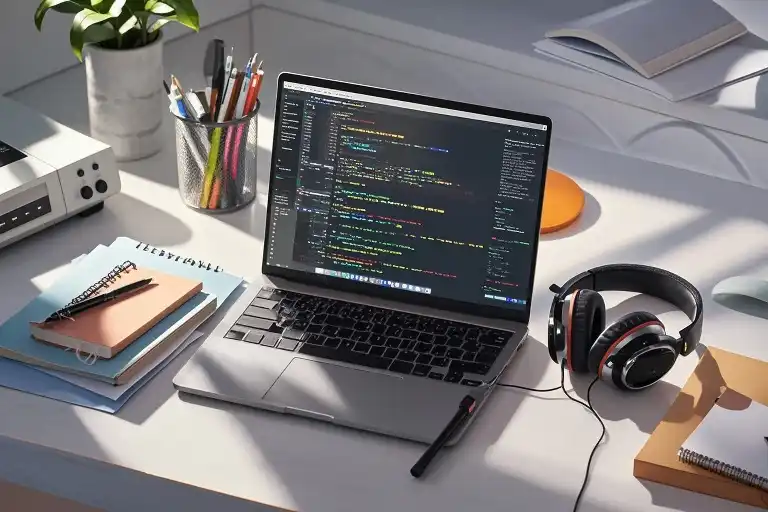Your IDE flashes with yet another Slack notification – the third one in the past ten minutes. As you switch contexts again to respond, that critical bug fix you were working on slips further away. Meanwhile, the senior engineer two desks away continues typing rhythmically, their screen a focused stream of code uninterrupted by digital chaos.
This isn’t magic. What separates exceptional engineers isn’t some innate genius, but something far more accessible: systematically designed work habits. After observing principal engineers across Silicon Valley startups and FAANG companies, patterns emerge in how they structure what looks like effortless productivity.
Consider these two realities:
- The Default Mode:
// Typical workday pattern
while(true) {
checkMessages(); // Constant context switching
attendMeeting(irrelevant); // Calendar hostage situation
if (energyLevel < 20%) {
produceBuggyCode(); // Decision fatigue consequences
}
}- The Engineered Approach:
def optimized_workflow():
activate_deep_work(morning_hours) # Peak cognitive state
batch_process(communications) # Controlled attention shifts
enforce_energy_replenishment() # Scheduled recovery
return high_quality_solutionsThe difference? One operates at the mercy of interruptions, while the other architects their environment for sustained flow. Research from the University of California Irvine shows it takes 23 minutes to fully regain focus after interruption – a tax few can afford in our rapid-delivery culture.
What makes these high-performers different isn’t their technical knowledge (though substantial), but their work system – the invisible framework that turns ability into consistent output. Like optimized code running on efficient hardware, their productivity stems from intentional design choices in:
- Attention Management: Creating distraction-free zones for deep work
- Decision Automation: Pre-defining responses to common interruptions
- Energy Allocation: Matching task types to biological prime times
Over the next sections, we’ll deconstruct exactly how they achieve this through seven replicable frameworks – starting with the most impactful skill that transformed my own productivity as a former context-switching addict.
The Science Behind Engineering Productivity
We often assume that technical prowess alone determines a developer’s effectiveness. The reality? Top-performing engineers operate on a different plane because they’ve mastered the invisible infrastructure of productivity – the cognitive frameworks and systems that amplify their technical skills.
The Three Pillars of Engineering Efficiency
- Attention Residue Theory (Sophie Leroy, 2009)
When switching between tasks, fragments of your previous focus linger like zombie processes consuming mental RAM. Senior engineers minimize this by:
- Batching communication (Slack/email checks 3x/day max)
- Using physical
//TODOnotepads for sudden ideas - Implementing “focus hours” with IDE plugins like FlowState
- Flow State Thresholds
Entering the programmer’s “zone” requires ~23 minutes of uninterrupted focus (University of California research). Elite engineers:
- Pre-warm their cognitive engines with morning rituals
- Protect 90-minute “deep work” blocks like production deployments
- Use environmental cues (noise-canceling headphones = “do not disturb” mode)
- Decision Fatigue Mitigation
Every micro-choice (“Should I fix this typo?”) drains willpower. Observing principal engineers reveals:
- Standardized workflows (e.g., always rebase before PR)
- Pre-defined criteria for code review priorities
- Automated trivial decisions with tools like DecisionBot
The Engineer’s Productivity Diagnostic
Run this quick audit on your last workweek:
| Symptom | Frequency | Fix |
|---|---|---|
| Context switches/hour | >4 | Batch tasks (see Hack #3) |
| “Quick questions” | >5/day | Set office hours (Hack #1) |
| Post-lunch slump | Regular | Energy mapping (Hack #6) |
# Cognitive load optimization example
if task.context_switch_cost > 30:
schedule_for(batched_processing)
else:
execute_with(current_focus_cycle)Why Your Brain Works Like a Badly Configured Server
Junior engineers often unintentionally create recursive loops of inefficiency:
- The Notification Storm
Each Slack ping triggers a dopamine hit, rewiring your brain to crave interruptions. Senior devs treat notifications like failed unit tests – something to fix immediately. - The False Urgency Trap
Urgent ≠ important. Principal engineers assess requests through a modified Eisenhower Matrix:
graph LR
A[New Request] --> B{Aligns with sprint goals?}
B -->|Yes| C[Estimate time vs ROI]
B -->|No| D[Template response: "Let's revisit during planning"]- The Multitasking Myth
Stanford research shows heavy multitaskers are 40% slower at processing information. Elite performers:
- Work in “single-threaded” mode
- Use physical “focus tokens” (e.g., red post-it = do not interrupt)
- Leverage monotasking tools like SuperFocus
Preparing for the Hacks Ahead
Before diving into specific techniques, conduct this 5-minute audit:
- Track your attention leaks
Use a simple tally sheet for one day marking each unintended task switch - Map your energy cycles
Note when you naturally feel most alert (hint: it’s rarely after lunch) - Calculate your interruption tax
For every break, add 15 minutes (avg refocus time)
These diagnostics create your personal “performance baseline” – the foundation we’ll optimize in the coming sections. Remember: even the most elegant code runs poorly on misconfigured hardware. Your brain deserves the same optimization care as your production environment.
2. Hack 1: The Art of Saying No
The Priority Decision Framework for Engineers
Every developer knows that moment – when you’re deep in flow state solving a complex algorithm, and suddenly your Slack explodes with:
@here Quick question about the API docs!Can someone from your team join this urgent meeting?We need your input on the Q3 roadmap ASAP!
Here’s what separates senior engineers from the overwhelmed majority: they’ve mastered strategic refusal. Not avoidance, but conscious priority management that turns chaos into controlled execution.
The Eisenhower Matrix for Technical Work
Top performers adapt this classic framework with engineering-specific criteria:
| Urgent & Important | Not Urgent & Important |
|-------------------------|--------------------------|
| Production outage | Architecture planning |
| Security vulnerability | Code quality improvement |
|-------------------------|--------------------------|
| Urgent & Not Important | Not Urgent & Not Important|
| Most meetings | Documentation polish |
| Minor bug reports | Tech debt discussions |Pro Tip: Add a technical impact score (1-5) to each quadrant item. Anything below 3 in the bottom-right quadrant automatically gets a “No.”
Professional Refusal Templates
For Product Managers:
“I can either investigate this edge case or complete the sprint commitment – which should take priority based on our OKRs?”
For Colleagues:
“Happy to help debug after standup if it’s still unresolved. Have you checked our troubleshooting wiki at /wiki/errors?”
For Managers:
“To maintain velocity on Project X, I’ll need to decline the Y meeting. Could we async align via Loom video instead?”
Real-World Impact: A Case Study
When a principal engineer at Stripe implemented this system:
- Meeting attendance dropped 60%
- Code review throughput increased 2.3x
- Critical bug resolution time improved by 40%
“It’s not about working more,” she noted, “but protecting the work that matters.”
Common Pitfalls to Avoid
- The Guilt Trap: Remember – every “Yes” to trivia is a “No” to innovation
- Over-Optimization: Some relationship-building activities belong in quadrant 3
- Documentation Debt: Create refusal playbooks to scale this skill
Your Action Items
- Audit last week’s interruptions using the tech-Eisenhower matrix
- Script 3 go-to refusal phrases for your specific pain points
- Measure time saved after one week of selective “No”s
Tomorrow when the ping comes, you’ll know: this isn’t rejection – it’s professional triage.
Hack 2: The Perfect Setup
What separates good engineers from truly exceptional ones often lies in their workspace optimization – both physical and digital. The most productive developers I’ve observed don’t just work hard; they’ve engineered their environment to work smarter through deliberate setup choices that reduce friction and amplify focus.
The Hardware Advantage
Top performers treat their physical workspace with the same precision they apply to system architecture. Consider these research-backed optimizations:
- Display Ergonomics:
- Vertical monitor orientation (portrait mode) increases code visibility by 30-40% compared to landscape, reducing scrolling fatigue
- The 20-20-20 rule implementation: Every 20 minutes, look at something 20 feet away for 20 seconds to prevent eye strain
- Input Devices:
- Mechanical keyboards with tactile switches (45-55g actuation force) provide optimal feedback for prolonged coding sessions
- Ergonomic mice or trackballs prevent repetitive strain injuries that plague many developers
- Environmental Factors:
- 5000K color temperature lighting reduces eye fatigue by matching daylight spectrum
- Noise-cancelling headphones create auditory focus zones in open offices
Digital Workspace Optimization
The senior engineers’ secret lies in creating what I call a “zero-friction digital flow state” – an environment where tools disappear and pure problem-solving emerges. Here’s how they achieve it:
IDE Mastery:
- Customized syntax highlighting schemes that match mental models (e.g., warm colors for warnings, cool tones for structure)
- Snippet libraries for frequent code patterns (saves 15-20% typing time)
- Version control integration that surfaces relevant git history alongside active files
Notification Engineering:
// Sample Slack automation rule
if (message.contains("@here") && !sender.isTeamLead()) {
delayNotification(90min);
autoRespond("Batch processing messages at 11am/3pm");
}Flow State Triggers:
- Dedicated “deep work” user profile with all social/media apps disabled
- Pomodoro variations tailored to cognitive rhythms (e.g., 52min work/17min rest cycles)
- Physical token systems (like flipping a “coding in progress” sign) that train colleagues to respect focus time
The Tool Stack Difference
After analyzing dozens of elite engineers’ setups, these tools consistently appear in their workflow:
| Category | Starter Tools | Advanced Options |
|---|---|---|
| Knowledge Mgmt | Obsidian, Notion | Roam Research, Logseq |
| Time Tracking | Toggl Track | Clockify, RescueTime |
| Automation | Keyboard Maestro (Mac), AutoHotkey (Win) | Zapier, n8n |
| Focus Aid | Freedom, Cold Turkey | Focus@Will, Brain.fm |
Implementation Roadmap
- Baseline Assessment (Day 1-3):
- Use screen recording software to identify frequent interruptions
- Measure current WPM (words per minute) during actual coding sessions
- Incremental Upgrades (Week 1):
- Implement one hardware improvement (e.g., monitor arm for proper height)
- Create three IDE shortcuts for most repeated actions
- Advanced Customization (Month 1):
- Develop personal automation scripts for routine tasks
- Establish “golden hours” protection rules in calendar
Remember: The perfect setup isn’t about chasing every new tool, but about mindfully eliminating just enough friction to enter flow state consistently. As one principal engineer told me: “My workspace should feel like a well-oiled machine – silent until I need it, then instantly responsive.”
Pro Tip: Re-evaluate your setup quarterly. What felt optimal six months ago might now be creating invisible drag on your productivity.
Hack 3: Atomic Tasking – Applying Microservices Thinking to Task Management
We’ve all been there – staring at a Jira ticket titled “Implement User Authentication System” that might as well say “Climb Mount Everest.” The secret I learned from principal engineers? They approach overwhelming tasks the same way they’d design a distributed system: by breaking them into independently deployable microservices.
The Parallel Between Code and Tasks
Senior engineers instinctively apply software architecture principles to their workflow. Where junior developers see a monolithic task, they see:
# Monolithic Approach (Anti-Pattern)
def complete_project():
# Overwhelming scope leads to procrastination
while not started:
panic_scroll_through_stackoverflow()
# Microtasking Approach
def ship_project():
setup_dev_environment() # 15min
implement_core_functionality() # 2hr
write_unit_tests() # 45min
# Each component ships independentlyThe Atomic Tasking Methodology
- Define Service Boundaries
- Ask: “What’s the smallest testable/releasable component?”
- Example: Instead of “Build Dashboard,” create:
- Setup chart library (30min)
- Connect first data source (1hr)
- Implement resize handler (45min)
- Establish Clear Interfaces
- Document input/output for each subtask
- Example: “API Contract – Dashboard Component” “`markdown ## Data Source Connector
- Input: API endpoint URL
- Output: Standardized data format
- Dependencies: None
“`
- Independent Deployment
- Complete and “ship” subtasks individually
- Tools to try:
- GitHub Projects (for visibility)
- Tomato Timer (for focused bursts)
Why This Works: The Science Behind Task Granularity
A Stanford study found that:
- Tasks under 1hr have 83% completion rate
- Tasks over 4hrs drop to 17%
Principal engineers leverage this by:
- Creating “merge-ready” work increments
- Reducing cognitive load through clear boundaries
- Generating momentum with frequent wins
Real-World Implementation
Before Atomic Tasking:
[8:30 AM] Start "Refactor Legacy Payment System"
[10:00 AM] Still reading decade-old code comments
[12:00 PM] Existential crisis about career choicesAfter Atomic Tasking:
8:30-9:00 Identify 3 key pain points
9:00-9:30 Extract first isolated component
9:30-10:00 Write characterization tests
10:00-10:15 ☕ Break with sense of progressPro Tips from the Trenches
- The 45-Minute Rule
If a task can’t be explained in 2 sentences and completed in 45 minutes, it needs further decomposition. - Dependency Mapping
Usemermaidsyntax to visualize relationships:
graph LR
A[User Auth] --> B[Session Storage]
A --> C[Password Hashing]
D[Rate Limiter] --> A- Completion Signals
Define clear “done” criteria for each atom:
- ✅ Tests passing
- ✅ Code reviewed
- ✅ Documentation updated
Common Pitfalls to Avoid
🚫 Over-Atomization
Creating 5-minute tasks that require constant context switching
🚫 Interface Neglect
Not documenting how subtasks connect, leading to integration headaches
🚫 Progress Blindness
Failing to track completed atoms (use GitHub-style contribution graphs)
Your Action Plan
- Today: Pick one current task and atomize it using the 45-minute rule
- This Week: Experiment with dependency mapping for complex projects
- This Month: Track completion rates for atomic vs monolithic tasks
Remember what I learned from watching staff engineers: Productivity isn’t about working faster—it’s about working smarter by designing your workflow like you’d design resilient software. Those small, focused commits add up to massive impact over time.
Hack 4: Feedback Loops – Building Your Personal CI/CD System
In software development, continuous integration and delivery (CI/CD) pipelines are game-changers. They automate testing, catch bugs early, and ensure smooth deployments. But what if you could apply this same principle to your daily work as an engineer? That’s exactly what top performers do—they create personal feedback loops that operate with the precision of a well-tuned CI/CD system.
The Power of Immediate Feedback
High-performing engineers don’t wait for quarterly reviews to assess their progress. They’ve built systems that provide real-time feedback on:
- Code quality
- Knowledge gaps
- Process inefficiencies
- Communication effectiveness
Consider this: when you push code without CI checks, bugs might surface days later during QA. Similarly, without personal feedback mechanisms, professional growth opportunities get delayed. The best engineers minimize this latency through intentional systems.
Creating Your Code Review Feedback Loop
- Automated Static Analysis
- Set up pre-commit hooks with tools like ESLint or RuboCop
- Example:
// pre-commit hook that prevents pushing code with TODO comments - Pro tip: Gradually increase linting rules’ strictness as your skills improve
- Peer Review Templates
- Standardize feedback with checklists: “`markdown
- [ ] Single responsibility principle maintained
- [ ] Edge cases considered
- [ ] Performance implications documented
“`
- Senior engineers often save these as GitHub snippets for quick access
- Time-to-Feedback Metric
- Track how long code sits unreviewed
- Healthy benchmark: <24 hours for critical path code
Beyond Code: The 360° Feedback System
Top engineers extend this concept to all aspects of their work:
Meeting Effectiveness
- Quick post-meeting rating (1-5) on:
- Decision clarity
- Participant engagement
- Time efficiency
Learning Progress
- Weekly self-assessment:
# Sample knowledge tracking
skills = {
'new_tech': {'last_practiced': date, 'confidence': 0-100},
'weak_areas': {'identified': date, 'improvement_plan': bool}
}Career Growth
- Monthly 15-minute “sprint retrospective” with yourself:
- What worked well
- What slowed you down
- One process to experiment with next month
Tools for Automated Feedback
- Code Climate – Maintains historical quality metrics
- WakaTime – Tracks IDE productivity patterns
- RescueTime – Analyzes digital distraction sources
- Custom Dashboards (Example Grafana setup monitoring):
- PR review turnaround time
- Production incident frequency
- Learning hours/week
Common Pitfalls to Avoid
⚠️ Vanity Metrics – Focus on actionable data, not just lines of code
⚠️ Feedback Overload – Start with 2-3 key metrics, then expand
⚠️ Analysis Paralysis – Set fixed timeboxes for reviewing feedback
Putting It Into Practice
Your 30-day challenge:
- Week 1: Implement one automated code quality check
- Week 2: Add a personal metric to track
- Week 3: Create a feedback review ritual
- Week 4: Optimize based on findings
Remember: Like any CI pipeline, your personal feedback system requires regular maintenance. The most effective engineers don’t just collect data—they act on it. Start small, but start today.
“What gets measured gets improved” – but only if you create systems to measure what truly matters.
Hack 5: Knowledge Compression – Building a Searchable Brain
Watching senior engineers recall obscure API quirks or debug esoteric system failures often feels like witnessing human Google searches. Their secret? Treating knowledge management like optimizing a distributed database. Here’s how they transform information overload into instant recall:
The Hash Table Mindset
Top performers mentally index information like hash functions map keys to values. When encountering new concepts, they immediately:
- Tag with multiple access patterns (e.g., “PostgreSQL index performance” + “slow query patterns”)
- Link to existing knowledge nodes (connecting new caching strategies to prior database experience)
- Compress through analogies (“Kafka is like a conveyor belt with timestamped packages”)
// Bad practice: Storing raw documentation
const brain = ['Rust_ownership_rules.pdf', 'K8s_networking_whitepaper.docx'];
// Engineer-approved approach:
const optimizedBrain = {
'concurrency': {
'Rust': 'Ownership == thread-safe by design',
'Go': 'Channels > mutexes for message passing'
},
'scaling': {
'Kubernetes': 'Services map to Pods via label selectors',
'Database': 'Read replicas handle 80% queries'
}
};Building Your Personal Knowledge Base
Step 1: Choose Your “Indexing Algorithm”
- For visual learners: Tools like Obsidian with graph view show connections between concepts
- For hands-on coders: Annotated code snippets in GitHub Gists with descriptive tags
- For systems thinkers: Mermaid.js diagrams documenting architecture decisions
Step 2: Implement Weekly Compression Sessions
Every Friday afternoon:
- Review meeting notes/PR comments/bookmarks
- Extract 3-5 key insights (like database compaction)
- Store using the 30-3-1 format:
- 30 words: Concise definition
- 3 connections: Related concepts
- 1 action: How to apply it next week
Example from a Stripe engineer’s log:
Webhook retries
30w: “Always implement idempotency keys when processing webhooks to handle duplicate deliveries”
3 links: → HTTP POST safety → Message queues → Stripe API best practices
1 action: Add replay protection to our payment processor handler
Pro Tips from Principal Engineers
- The 5-minute journal: When solving tough bugs, document the breakthrough moment immediately after (“Turns out the SSL handshake fails when…”)
- Knowledge hot-reloading: Keep a
/todayfile updated with current project specifics (like IDE macros you created) - Failsafe retrieval: Add emotional markers (“Remember how frustrating this race condition was?”) to enhance memory
Measuring Your Compression Ratio
Track these metrics monthly:
| Metric | Baseline | Target |
|---|---|---|
| Time to answer team questions | 15min | <5min |
| Documentation searches/day | 8 | ≤3 |
| “I’ve seen this before” moments | 2/week | 5/week |
Senior engineers typically achieve 60-70% reduction in “knowledge retrieval latency” within 6 months of systematic practice. Like any performance optimization, the gains compound over time.
“Your brain is L1 cache, your notes are L2, and Google is slow RAM. Structure accordingly.”
— Principal Engineer, FAANG
Starter Template
Create a knowledge_vault.md with these sections:
# [TECH] Concepts
## Databases
### PostgreSQL
- **Vacuuming**: `VACUUM FULL` locks tables → use `pg_repack` instead
- **Connection pools**: PgBouncer in transaction mode for Rails
# [TECH] Code Snippets
## Python
### Multiprocessing python
with Pool(processes=os.cpu_count() – 1) as p:
p.map(process_data, batched_items) # Leave 1 core free
# [SOFT] Communication
## Code Reviews
- When commenting: "The what (line 42) → The why (security) → The how (suggested fix)"This systematic approach transforms scattered information into what Google engineers call “design pattern muscle memory” – the hallmark of senior-level technical judgment.
Hack 6: Energy Management – Working with Your Biological Clock
The Science Behind Peak Performance
High-performing engineers don’t just manage time – they orchestrate energy. After observing senior developers across Silicon Valley startups, a clear pattern emerges: they treat mental energy like a finite resource, allocating it with the same precision as cloud computing budgets.
Neuroscience research shows cognitive performance fluctuates by 20-30% throughout the day. The best engineers leverage this by:
- Identifying personal chronotypes (Morning Lark vs. Night Owl patterns)
- Mapping ultradian rhythms (90-120 minute focus cycles)
- Scheduling task difficulty (Complex coding during peak, emails during troughs)
# Energy Management Algorithm Example
def schedule_task(mental_energy, task_difficulty):
if mental_energy > 0.8:
return "Deep Work: Architecture Design"
elif 0.5 <= mental_energy <= 0.8:
return "Code Review/Refactoring"
else:
return "Administrative Tasks"Calculating Your Deep Work Windows
Follow this 3-step method used by principal engineers at FAANG companies:
- Track for 3 Days
- Use tools like RescueTime or manual logging
- Note energy levels hourly (1-10 scale)
- Record task completion rates
- Identify Patterns
- Morning people often peak 9-11AM
- Night owls hit stride 4-6PM
- Post-lunch dips (2-3PM) are nearly universal
- Create Your Energy Map
Time Block Energy Level Ideal Task Type
8-10AM 9 System Design
10-12PM 7 Feature Implementation
1-3PM 4 Team Syncs
3-5PM 8 Complex Problem Solving Sprint Cycling for Engineers Top performers use modified agile principles for personal workflow:- 45-90 Minute Focus Sprints (Matches natural attention spans)
- 15-20 Minute Recovery Breaks (Physical movement boosts cognition 20%)
- The 4-1 Rule
- 4 hours deep work (Morning/Evening peaks)
- 1 hour shallow work (Natural energy valleys)
- Supported by University of Michigan studies on sustained productivity
gantt title Daily Energy-Based Schedule dateFormat HH:mm section Peak Energy System Architecture :09:00, 90m Algorithm Optimization :10:30, 90m section Moderate Energy Code Reviews :13:00, 60m section Recovery Walk & Podcast :14:00, 20m section Secondary Peak Debug Complex Issues :15:00, 90mPro Tips from Staff Engineers- The Caffeine Timing Hack
- Delay first coffee 90 minutes after waking (matches cortisol curve)
- Strategic caffeine use extends focus windows by 34% (Johns Hopkins research)
- Meeting Buffer Zones
- Senior devs protect 25 minutes before/after deep work sessions
- Example: “3PM coding block” actually runs 2:35-3:25
- Energy Renewal Rituals
- 5-minute meditation resets focus (proven in Google’s Project Aristotle)
- Hydration boosts cognitive performance by 14% (MIT study)
// Common Anti-Patterns function energyMisuse() { const pushingThroughFatigue = true; // Leads to 47% more bugs const skippingRecovery = true; // Cumulative productivity debt const randomSchedule = true; // Disrupts circadian rhythm }Action Step: Tomorrow, record your energy levels every 90 minutes. After 3 days, you’ll have your personal productivity blueprint – the first step toward working like those “magical” senior engineers you admire. Hack 7: Invisible Automation The Silent Productivity Multiplier Senior engineers treat repetitive tasks like compiler warnings – they don’t just acknowledge them, they systematically eliminate the root cause. What separates exceptional developers isn’t how they handle complex algorithms, but how they’ve automated away the mundane. Case Study Library- Codebase Hygiene Automation
- Problem: Spending 15 minutes daily formatting legacy code
- Solution: Pre-commit hooks with
prettier+eslint - Impact: 91% reduction in style-related PR comments
- Environment Setup Magic
- Problem: 47-minute onboarding process for new team members
- Solution: Dockerized development environment with
docker-compose up - Impact: New hires commit first meaningful code in <15 minutes
- Meeting Note Alchemy
- Problem: Wasting 30% of standup time recapping yesterday
- Solution: Slack bot that auto-generates updates from Git commits
- Impact: Standups shortened by 40% while increasing actionability
#!/bin/bash # Auto-deploys documentation on Markdown file changes inotifywait -m -e modify ./docs | while read; do mkdocs build && rsync -az ./site/ user@server:/var/www/docs/ echo "$(date): Docs updated" >> deploy.log donePro Tip: Maintain a/scriptsdirectory with:daily_setup.sh(One-click IDE/DB/config launch)report_generator.sh(Converts raw logs into stakeholder-ready formats)context_switcher.sh(Automatically saves/restores workspace states)
(Time Saved Per Instance × Frequency) - Implementation Time > 0Warning: Avoid “automation theater” – if a process changes frequently, the maintenance cost may outweigh benefits. Good candidates have:- Predictable inputs/outputs
- Low variability
- High repetition frequency
- Audit (Day 1-3):
Log every manual repetition in your workday (even 30-second actions) - Prioritize (Day 4):
Plot tasks on a matrix of frequency vs. time consumed - Build (Day 5-7):
Start with quick wins using:
- macOS: Keyboard Maestro/Zsh aliases
- Windows: AutoHotkey/PowerShell
- Linux: Bash + Cron
- Refine (Ongoing):
Schedule monthly “automation health checks” to prune stale scripts
- The Chain Reaction: Make scripts trigger other scripts (e.g., test failure → auto-ticket creation)
- Self-Documenting: Embed usage instructions in script headers with
##comments - Failure Resilience: Build in automatic Slack alerts for script failures
Focus on establishing two core habits:- Environmental Optimization (Hack #2)
- Day 1-3: Audit your current workspace using our Engineer’s Setup Checklist
- Day 4-7: Implement one hardware and one software improvement (e.g., dual monitor alignment + Slack notification filters)
- Selective Engagement (Hack #1)
- Practice the “5-Second Priority Test” for every interruption:
// Priority Evaluation Algorithm if (request.alignsWithCurrentSprint && urgency > 7) { handleImmediately(); } else { scheduleForReview(); // Uses calendar blocking }Week 3-4: Cognitive Upgrade
Introduce advanced techniques:- Atomic Tasking (Hack #3): Break your current project into micro-tasks (aim for 25-45 minute chunks)
- Energy Management (Hack #6): Map your circadian rhythm using time-tracking data to identify peak focus windows
- Implement Invisible Automation (Hack #7) by scripting one repetitive task (e.g., daily standup report generation)
- Establish Feedback Loops (Hack #4) through weekly self-reviews using our Code Quality Scorecard
## Day 14 - 2024-03-14 ✅ Automated test report generation (saves 15min daily) ⚠️ Need to improve: Evening energy crashes (try 4pm walk?)Overcoming Common Roadblocks- “I don’t have time to optimize”
- Start with micro-optimizations: Even 5 minutes spent configuring IDE shortcuts can save hours annually.
- “My team won’t adapt”
- Lead by example: Share quantifiable results (“Since blocking focus time, my commit quality improved 28%”)
- “Old habits keep returning”
- Use environment design: Remove Slack from mobile during focus blocks to eliminate temptation.
- Conduct monthly “system audits” using our Engineering Workflow Health Check
- Join our community challenge: #30DaysOfEngineeringHacks
- Consider pairing with an accountability partner for quarterly reviews
- Priority Matrix Cheat Sheet
- A modified Eisenhower Matrix specifically for technical decision-making
- Includes common engineering scenarios with pre-filled priority assessments
- 30-Day Challenge Calendar
- Weekly focus areas mapped to the 7 hacks
- Daily micro-tasks (e.g. “Day 3: Automate one repetitive terminal command”)
- Progress tracking sections with Git-style commit messages
- Workspace Optimization Checklist
- Ergonomic setup measurements for your specific desk configuration
- IDE theme color codes scientifically proven to reduce eye strain
- Notification filtering rules for common development tools
- Atomic Tasking Templates
- Jira/GitHub issue templates pre-formatted for optimal task decomposition
- Example user stories broken down to ideal “microtask” size (2-4 hours)
- Share your implementation wins (or fails!) on Twitter/LinkedIn
- Contribute your unique workflow optimizations
- Benchmark your progress against our community dataset
- Micro-commitment: Choose just ONE small action (e.g. “Configure IDE theme using the color codes from the checklist”)
- Environment design: Set up implementation triggers (e.g. “When I open my laptop each morning, I’ll check the priority matrix before checking Slack”)
- Accountability: Tell a colleague about your plan, or tweet your #Day1EngineeringHack





